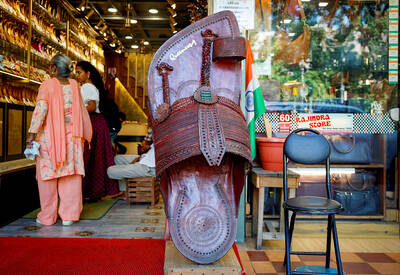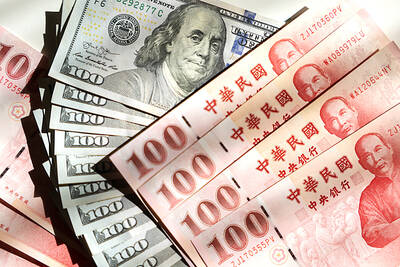A high-tech fish farm floats just off the coast of Singapore, part of a plan by a retired engineer who once built oil rigs to bring diners cleaner, healthier seafood.
The tiny city-state imports 90 percent of its food, but hopes to locally source about one-third of it by 2030 to guard against supply disruptions such as climate change, disease and conflict.
So officials are backing projects such as Eco-Ark, a giant aquafarm that produces seabass, grouper and threadfin for restaurant tables across the city of nearly 6 million.

Photo: AFP
The facility harvests 30,000kg a month, which ex-engineer Leow Ban Tat (廖萬達), founder of Eco-Ark and the Aquaculture Centre of Excellence, said is 20 times more per hectare than traditional open-net cage farms.
“There is a great difference in what we do because we believe in technology,” said Leow, who once built oil rigs.
The structure, which sits on a purpose-built submersible platform, filters seawater through an ozone machine to kill disease-causing pathogens before transferring it into fish tanks 6m deep.
The tanks simulate ocean conditions to keep the fish swimming against the current, making them leaner and more nutritious, and shield them from threats such as disease, plankton blooms and oil spills.
Leow, 65, said the water is so clean that, unlike other farms, Eco-Ark has no need to add antibiotics, which help protect fish from disease but can cause resistance in humans over time and affect the environment.
Adult fish are given frozen squid as well as pelleted feed, with younger ones also given probiotics, “which helps with both digestion and physiological function and improves the performance of the animal,” he said.
Leow is also looking to cut emissions from his “fish farms of the future” by adding solar panels and has built a hatchery after finding that juvenile fish imported from Malaysia and Australia carried diseases.
Eco-Ark’s fish are delivered to more than 80 restaurants, supermarkets and specialty shops that put a premium on them being freshly harvested and healthy.
Leow said he hopes eventually to export not only the fish, but the technology for the Eco-Ark, which could be built near coastal areas to shorten delivery time and cut costs.
“It is very important that local farmers [who] actually know the economy” should be encouraged to help meet demand, said Daniel Teo, cofounder of Singapore’s Kin Hoi restaurant, which buys fish from the Eco-Ark facility.
Food security has become a major issue for Singapore — about the size of New York City, but without the space to meet its agricultural and industrial needs — so funding has been granted for everything from rooftop vegetable farms to Eco-Ark’s fish farm.
However, Madhumitha Ardhanari, principal sustainability strategist at the Forum for the Future nonprofit group, said that Singaporean fish farmers’ heavy reliance on government subsidies raised concerns about their long-term survival.
Kin Hoi diner Martin Pei had no complaints as he polished off a portion of fried seabass from Eco-Ark.
“The fish was really delicious,” he said. “Just eating it, I didn’t know that it was farmed.”

MARKET LEADERSHIP: Investors are flocking to Nvidia, drawn by the company’s long-term fundamntals, dominant position in the AI sector, and pricing and margin power Two years after Nvidia Corp made history by becoming the first chipmaker to achieve a US$1 trillion market capitalization, an even more remarkable milestone is within its grasp: becoming the first company to reach US$4 trillion. After the emergence of China’s DeepSeek (深度求索) sent the stock plunging earlier this year and stoked concerns that outlays on artificial intelligence (AI) infrastructure were set to slow, Nvidia shares have rallied back to a record. The company’s biggest customers remain full steam ahead on spending, much of which is flowing to its computing systems. Microsoft Corp, Meta Platforms Inc, Amazon.com Inc and Alphabet Inc are

Luxury fashion powerhouse Prada SpA has acknowledged the ancient Indian roots of its new sandal design after the debut of the open-toe footwear sparked a furor among Indian artisans and politicians thousands of miles from the catwalk in Italy. Images from Prada’s fashion show in Milan last weekend showed models wearing leather sandals with a braided design that resembled handmade Kolhapuri slippers with designs dating back to the 12th century. A wave of criticism in the media and from lawmakers followed over the Italian brand’s lack of public acknowledgement of the Indian sandal design, which is named after a city in the

The US overtaking China as Taiwan’s top export destination could boost industrial development and wage growth, given the US is a high-income economy, an economist said yesterday. However, Taiwan still needs to diversify its export markets due to the unpredictability of US President Donald Trump’s administration, said Chiou Jiunn-rong (邱俊榮), an economics professor at National Central University. Taiwan’s exports soared to a record US$51.74 billion last month, driven by strong demand for artificial intelligence (AI) products and continued orders, with information and communication technology (ICT) and audio/video products leading all sectors. The US reclaimed its position as Taiwan’s top export market, accounting for

INVESTOR RESILIENCE? An analyst said that despite near-term pressures, foreign investors tend to view NT dollar strength as a positive signal for valuation multiples Morgan Stanley has flagged a potential 10 percent revenue decline for Taiwan’s tech hardware sector this year, as a sharp appreciation of the New Taiwan dollar begins to dent the earnings power of major exporters. In what appears to be the first such warning from a major foreign brokerage, the US investment bank said the currency’s strength — fueled by foreign capital inflows and expectations of US interest rate cuts — is compressing profit margins for manufacturers with heavy exposure to US dollar-denominated revenues. The local currency has surged about 10 percent against the greenback over the past quarter and yesterday breached